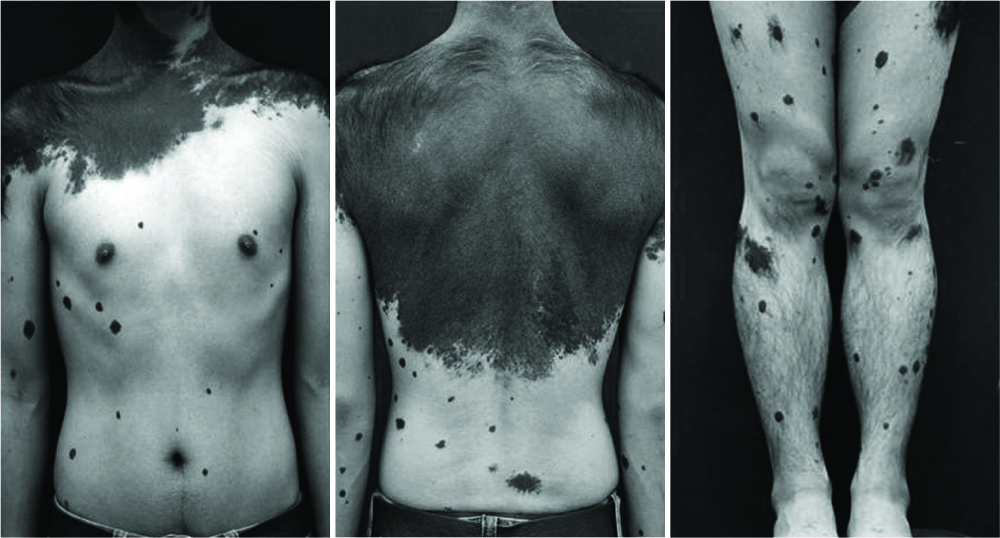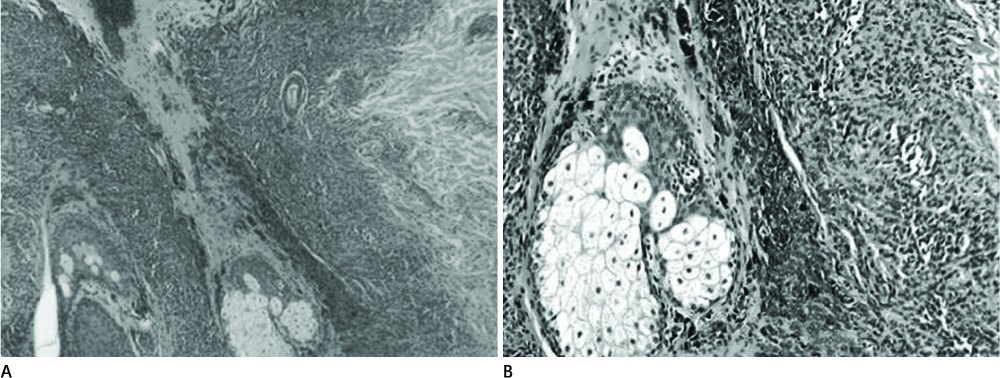J Korean Soc Radiol.
2011 Dec;65(6):537-541. 10.3348/jksr.2011.65.6.537.
Neurocutaneous Melanosis: A Case Report
- Affiliations
-
- 1Department of Radiology, Busan Paik Hospital, Inje University College of Medicine, Busan, Korea. hwjeong2000@lycos.co.kr
- KMID: 2002918
- DOI: http://doi.org/10.3348/jksr.2011.65.6.537
Abstract
- Neurocutaneous melanosis is a rare disorder characterized by the presence of a large or multiple congenital melanocytic nevus with proliferation of melanocytes in the central nervous system. The prognosis of neurocutaneous melanosis is extremely poor and its diagnostic approach requires understanding its brain magnetic resonance imaging findings. We report a patient with asymptomatic neurocutaneous melanosis and its radiologic findings.
MeSH Terms
Figure
Reference
-
1. Smith AB, Rushing EJ, Smirniotopoulos JG. Pigmented lesions of the central nervous system: radiologic-pathologic correlation. Radiographics. 2009; 29:1503–1524.2. Vanzieleghem BD, Lemmerling MM, Van Coster RN. Neurocutaneous melanosis presenting with intracranial amelanotic melanoma. AJNR Am J Neuroradiol. 1999; 20:457–460.3. Ye BS, Cho YJ, Jang SH, Lee BI, Heo K, Jung HH, et al. Neurocutaneous melanosis presenting as chronic partial epilepsy. J Clin Neurol. 2008; 4:134–137.4. Agero AL, Benvenuto-Andrade C, Dusza SW, Halpern AC, Marghoob AA. Asymptomatic neurocutaneous melanocytosis in patients with large congenital melanocytic nevi: a study of cases from an Internet-based registry. J Am Acad Dermatol. 2005; 53:959–965.5. Hsueh CW, Ho CS, Chiu NC, Shen EY. Neurocutaneous melanosis with hydrocephalus: report of one case. Acta Neurol Taiwan. 2004; 13:29–33.6. Hayashi M, Maeda M, Maji T, Matsubara T, Tsukahara H, Takeda K. Diffuse leptomeningeal hyperintensity on fluid-attenuated inversion recovery MR images in neurocutaneous melanosis. AJNR Am J Neuroradiol. 2004; 25:138–141.7. Warakaulle DR, Anslow P. Differential diagnosis of intracranial lesions with high signal on T1 or low signal on T2-weighted MRI. Clin Radiol. 2003; 58:922–933.8. Bittencourt FV, Marghoob AA, Kopf AW, Koenig KL, Bart RS. Large congenital melanocytic nevi and the risk for development of malignant melanoma and neurocutaneous melanocytosis. Pediatrics. 2000; 106:736–741.9. DeDavid M, Orlow SJ, Provost N, Marghoob AA, Rao BK, Wasti Q, et al. Neurocutaneous melanosis: clinical features of large congenital melanocytic nevi in patients with manifest central nervous system melanosis. J Am Acad Dermatol. 1996; 35:529–538.10. Chu WC, Lee V, Chan YL, Shing MM, Chik KW, Li CK, et al. Neurocutaneous melanomatosis with a rapidly deteriorating course. AJNR Am J Neuroradiol. 2003; 24:287–290.
- Full Text Links
- Actions
-
Cited
- CITED
-
- Close
- Share
- Similar articles
-
- Dandy-Walker Malformation Associated with Neurocutaneous Melanosis
- A Case of Neurocutaneous Melanosis in a 46-year Old Man
- A Case Report of Giant Pigmented Nevus Associated with Porencephaly: A Variant of Neurocutaneous Melanosis
- A Case of Neurocutaneous Giant Melanosis Associated with Dandy-Walker Syndrome
- A case of congenital neurocutaneous melanosis





